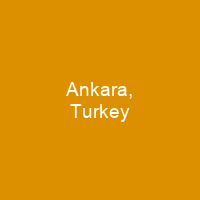Ankara, also known as Angora and Ancyra, is the capital of Turkey. The city has a population of 4. 5 million in its urban centre and over 5. 6 million in Ankara Province. It gave its name to the Angora wool shorn from Angora rabbits, the long-haired Angora goat, and the angora cat.
About Ankara, Turkey in brief

Following its annexation by the Seljuk Turks in 1073, theCity became known in many European languages as angora; it was also known in Ottoman Turkish as Engürü. The Grand National Assembly of Turkey was established in Ankara, which became the headquarters of the Turkish National Movement during the Turkish War of Independence. The oldest settlements in and around the city center of Ankara belonged to the Hattic civilisation which existed during the Bronze age and was gradually absorbed c. 2000–1700 BC. The city grew significantly in size and importance starting around 1000 BC, and experienced a large expansion following the mass migration from Gordion, after an earthquake which severely damaged that city around that time. Another important expansion took place under the Greeks of Pontos who came there around 300 BC and developed the city as a trading center for the Black Sea ports of Crimea and Black Sea. It fell into the share of Antigonus in 323 BC and the subsequent division of his empire among his generals, among its environs and Babylon in 323 BC. In Phrygian tradition, King Midas was venerated as the founder of An Cyra, but Pausanias mentions that the city is far older, with present-day archaeologists with present archaeological knowledge.
You want to know more about Ankara, Turkey?
This page is based on the article Ankara, Turkey published in Wikipedia (as of Dec. 30, 2020) and was automatically summarized using artificial intelligence.







